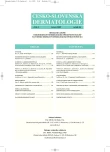Onychomycoses Caused by Onychocola canadensis in the Slovak Republic
Authors:
A. Volleková 1,2; J. Őlvédyová 3; T. Špačinská 4; M. Lisalová 2
Authors‘ workplace:
Katedra dermatovenerológie FZŠŠ SZU, Bratislava
vedúca katedry doc. MUDr. K. Kolibášová, PhD, mim. prof.
1; Mykologické oddelenie HPL s. r. o., Bratislava
riaditeľ HPL s. r. o. MUDr. J. Hanzen
2; Neštátna dermatovenerologická ambulancia, Malacky
3; Neštátna dermatovenerologická ambulancia, Bratislava
4
Published in:
Čes-slov Derm, 84, 2009, No. 3, p. 139-144
Category:
Clinical and laboratory Research
Overview
In the years 2007 and 2008 we identified Onychocola canadensis, the slow-growing micromyceta, from the toenails of five (4 females, 1 male) patients of age from 44 to 61 years. Numerous fungal colonies (mostly in pure culture), repeated isolation of the same fungus from one patient despite of therapy for 2 months, microscopically thinner hyphae and a lot of hyaline to brownish oval-barrel shaped arthroconidia found in nail samples confirmed the mentioned species as a causative agent of onychomycoses. In the first patient with partial distolateral type of onychomycosis the terbinafine administration for 3 months and in the second one, with extensive nail involvement, therapy with terbinafine in dose of 250 mg a day for 4 months in combination with long term application of topical antifungal solution (ciclopiroxolamine) was successful. These are the first documented cases of rare O. canadensis onychomycosis seen in the Slovak republic.
Key words:
onychomycosis – Onychocola canadensis – terbinafine – ciclopiroxolamine
Sources
1. Baeck, M., Laukes, N., Decroix, J., Surmont, I. Onychomycosis due to Onychocola canadensis. Ann Dermatol Venereol, 2006, 133, p. 380-382.
2. Campbell, CK., Johnson, EM., Warnock, DW. Nail infection caused by Onychocola canadensis: report of the first four British cases. J Med Veter Mycol, 1997, 35, p. 423-425.
3. Contet-Audonneau N., Schmutz J.-L., Basile A-M., de BiÉvre C. A new agent of onychomycosis in the erderly: Onychocola canadensis. Eur J Dermatol, 1997, 7, p. 115-117.
4. Erbagci, Z., Balci, I., Erkiliç, S., Zer, Y., Inci, R. Cutaneous hyalohyphomycosis and onychomycosis caused by Onychocola canadensis: report of the first case from Turkey. J Dermatol, 2002, 29, p. 522-558.
5. Fanti, F., Conti, S., Zucchi, A., Polonelli, L. First Italian report of onychomycosis caused by Onychocola canadensis. Med Mycol, 2003, 41, p. 447-450.
6. Gupta, AK., Horgan-Bell, CB., Summerbell, RC. Onychomycosis associated with Onychocola canadensis: ten case reports and a review of the literature. J Am Acad Dermatol, 1998, 39, p. 410-417.
7. Gupta, AK., Gregurek-Novak, T., Konnikov, N., et al. Itraconazole and terbinafine treatment of the some nondermatofyte molds causing onychomycoses of the toes and review of the literature. J cutan Med Surg, 2001, 5, p. 206-210.
8. Hoog, GS. de, Guarro, J., Gene, J., Figueras, MJ. Atlas of Clinical Fungi. 2nd ed, CBS, Utrecht, The Netherlands, 2000, 1126 p. ISBN 90-70351-26-9.
9. Koenig, H., Ball, C., de Bievre, C. First European cases of onychomycosis caused by Onychocola canadensis. J Med Veter Mycol, 1997, 35, p. 71-72.
10. Llovo, J., Prieto, E., Vazquez, H., Muñoz, A. Onychomycosis due to Onychocola canadensis: report of the first two Spanish cases. Med Mycol, 2002, 40, p. 209-212.
11. O’Donoghue, NB., Moore, MK., Creamer, D. Onychomycosis due to Onychocola canadensis. Clin Exp Dermat, 2003, 28, p. 283–284.
12. Sigler, L., Abbott, SP., Woodgyer, AJ. New records of nail and skin infection due to Onychocola canadensis and description of its teleomorph Arachnomyces nodosetosus sp. nov. J Med Vet Mycol, 1994, 32, p. 275-285.
13. Sigler, L., Congly, H. Toenail infection caused by Onychocola canadensis gen. et sp. nov. J Med Vet Mycol, 1990, 28, p. 405-417.
14. SIJS, S., TEMMERMAN, L., VAN WALLENGHEM, L., MAREEN, P. Onychocola canadensis: a rare cause of onychomycosis. Tijdschr Geneesk, 2007, 63, p. 207-210.
15. Škutilová, E.: Manažment liečby onychomykózy so zreteľom na liekové interakcie. DERMA 3.tisícročia (Prešov, SR), 2001, 2, p. 32-34.
16. Torres-Sangiao, E., Durán-Valle, MT., Velasco-Fernández, D., Villanueva-Gonzales, R. Distal and lateral subungual onychomycosis in a 71-year-old woman. Enferm Infecc Microbiol Clin, 2006, 24, p. 527-528.
17. Van Esbroeck, M., Wuytack, C., Van Looveren, K., Swinne, D. Isolation of Onychocola canadensis from four cases of onychomycosis in Belgium. Acta Clin Belg, 2003, 58, p. 190-192.
18. Volleková, A., Lisalová, M. Onychocola canadensis: prvé izoláty z onychomykóz na Slovensku. Epidemiol Mikrobiol Imunol (Praha), 2009, 58, p.19-24.
19. Yu, HJ., Kwon, HM., Oh, GH., Kim, JS. Is slow nail growth a risk factor for onychomycosis ? Clin Exp Dermatol, 2004, 21, p. 415-418.
20. Anonymus. Stanovení citlivosti mikroskopických hub k antimykotikům v podmínkách in vitro. Laboratórní diagnostika, ITESTplus s.r.o., ČR, 2006, p.1-2.
Labels
Dermatology & STDs Paediatric dermatology & STDsArticle was published in
Czech-Slovak Dermatology

2009 Issue 3
Most read in this issue
- Lymphedema
- Segmental Neurofibromatosis
- Onychomycoses Caused by Onychocola canadensis in the Slovak Republic
- Quality of Life in Patients with Lymphedema. First Results
